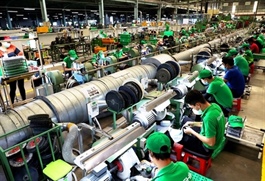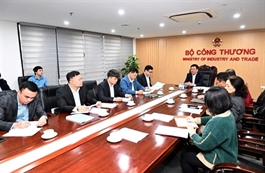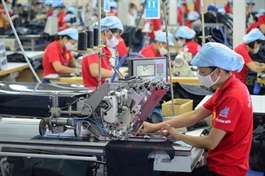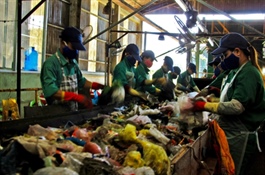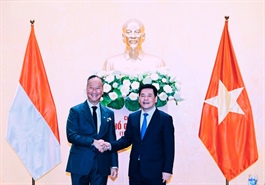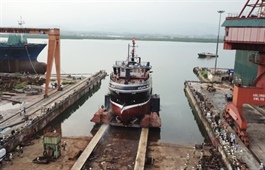Vietnam to set up task force to speed up renewable projects
Vietnam to set up task force to speed up renewable projects
Several LNG and offshore wind power projects may struggle to be commercially operational before 2030.
The Ministry of Industry and Trade (MoIT) has proposed the establishment of an inter-agency task force to address obstacles for LNG (liquefied natural gas) and offshore wind power projects to be commissioned before 2030.
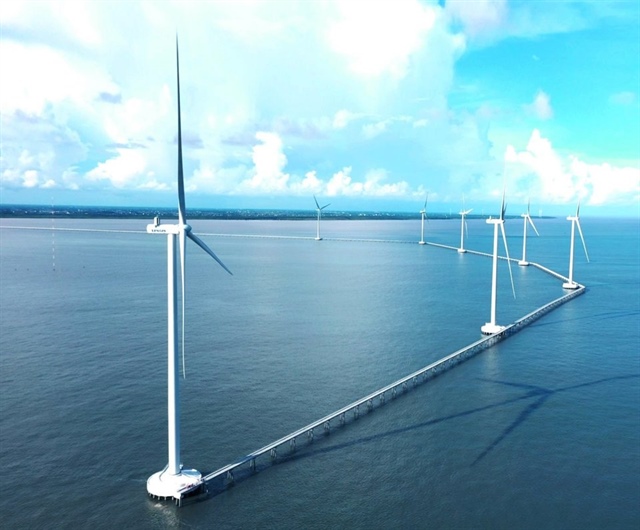
An offshore wind power project in Soc Trang Province, Vietnam. Photo: The Hanoi Times |
According to the Power Development Plan VIII (PDP8), the total capacity of 23 gas-fired power projects to be operational by 2030 is over 30,420 MW, of which 13 will use LNG, accounting for 74% of the total capacity. Currently, only the O Mon I Thermal Power Plant (660 MW) has been operational since 2015, and the Nhon Trach 3 and 4 Thermal Power Plants (1,624 MW) are under construction. The remaining 18 projects are in the preparation phase (23,640 MW), and 3 others are selecting investors (4,500 MW).
Offshore wind power is expected to reach around 6,000 MW by 2030, according to the PDP8. However, no projects have yet been decided on or allocated to an investor.
The Ministry of Industry and Trade (MoIT) expressed concern that LNG and offshore wind power projects may struggle to be commercially operational before 2030. The implementation of LNG projects typically takes 7-8 years, and offshore wind power projects 6-8 years, while many policies for these types of energy sources are still unclear.
In a recent report sent to the Prime Minister, the ministry highlighted the barriers to developing these projects as a "very new issue, involving multiple authorities and sectors." Therefore, the ministry proposed to the Prime Minister that an inter-agency government task force be established to study, propose mechanisms, and policies, and coordinate the modification of synchronized regulations.
Issues in the development of LNG projects are outlined in the energy management agency's report to the government. These include a lack of legal framework for negotiating power purchase agreements (PPAs) with long-term production commitments and the mechanism to convert gas prices into electricity prices. These are also reasons why the Nhon Trach 3 and 4 projects, though 73% complete, have not yet finalized PPA negotiations with the Vietnam Electricity (EVN).
Moreover, foreign investors have additional requirements, such as applying foreign laws (British or Singaporean), government payment and termination guarantees from EVN, and foreign exchange risk related to project interconnection and transmission progress.
The MoIT stated that there are currently no regulations on minimum production commitments for power plants participating in the electricity market. EVN and the plant owners negotiate and agree on the production quantities according to the contracts.
However, this can lead to situations where committed production exceeds actual demand. In such cases, the plant will not generate electricity, but EVN will still have to pay, affecting the financial balance of the group. Therefore, the MoIT recommended that the Government instruct relevant ministries to establish financial mechanisms for EVN to avoid putting pressure on electricity prices and burdens on the state agency.
Regarding EVN's obligation guarantee in power purchase agreements, the MoIT stated that this is a simple commercial contract between the investor and the enterprise, and the Government does not fulfill this guarantee obligation. In other words, state-owned enterprises must take responsibility for their capital like other businesses, according to the ministry.
Furthermore, there is currently no mechanism for the State Bank of Vietnam to guarantee exchange rates for investors. This means there is a legal gap in implementing foreign exchange conversion guarantees for gas power projects, according to the report sent to the Prime Minister.
With the mechanism of converting gas prices to electricity prices, the MoIT stated that the Government has agreed in principle to convert gas prices to electricity prices for projects such as Block B, Blue Whale, LNG Nhon Trach 3 and 4. However, the Government noted that the negotiation of electricity and gas production commitments at the Nhon Trach 3 and 4 projects is a business agreement between enterprises.
Due to various obstacles and a lack of legal foundation, the ministry estimated that only six projects, with a total capacity of 6,600 MW, will be operational before 2030. These include O Mon Power Center projects, Nhon Trach 3, Nhon Trach 4, and Hiep Phuoc. The remaining projects will only be commissioned before 2030 if power purchase agreement negotiations and capital arrangements are completed before 2027. As for gas-fired power projects in Block B, Blue Whale chain, it depends on the progress of the upstream gas project – Block B.
Regarding offshore wind power, the reason for no projects being implemented is due to various regulations in the Law on Resources, Sea and Island Environmental Law, Investment Law, Bidding Law, and National Marine Spatial Planning.
In addition, to ensure that LNG and offshore wind power projects are operational according to PDP8, mechanisms related to laws such as Land Law, Price Law, Bidding Law, Electricity Law, and related guidance documents need to be revised and resolved by the competent authorities.
In late November, businesses proposed to the MoIT that a resolution and policy from the relevant authorities regarding special mechanisms for investors deploying projects of these two types of energy sources is needed.






